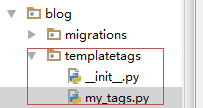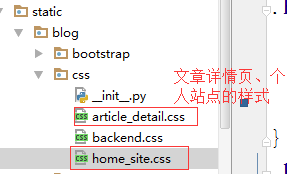一. 文章详情页的设计和数据构建
url.py
# 文章详情页 re_path('^(?P<username>w+)/articles/(?P<article_id>d+)$', views.article_detail), # w+:数字和字母
views.py
def get_query_data(username): # 查询相关的数据,获取分类的数据 ''' 由于数据很多个地方需要用到,所以可以解耦出来,单独写一个函数 :param username: :return: ''' user = UserInfo.objects.filter(username=username).first() blog = user.blog cate_list = models.Category.objects.filter(blog=blog).values("pk").annotate(c=Count("article__title")).values( "title", "c") tag_list = models.Tag.objects.filter(blog=blog).values("pk").annotate(c=Count("article__title")).values("title", "c") from django.db.models.functions import TruncMonth date_list = models.Article.objects.filter(user=user).annotate(month=TruncMonth("create_time")).values( "month").annotate(c=Count("title")).values("month", "c") return {"blog": blog, "cate_list": cate_list, "tag_list": tag_list, "date_list": date_list} def article_detail(request, username, article_id): # url:127.0.0.1:8000/mm/articles/1 context = get_query_data(username) return render(request, "article_detail.html", context)
base.html(继承)
<!DOCTYPE html> <html lang="en"> <head> <meta charset="UTF-8"> <title>Title</title> <link rel="stylesheet" href="/static/blog/bs/css/bootstrap.css"> <style> *{ margin: 0; padding: 0; } .header{ width: 100%; height: 60px; background-color: #369; } .content .title{ font-size: 18px; font-weight: 100; line-height: 60px; color: white; margin-left: 20px; } .backend{ float: right; color: white; text-decoration: none; font-size: 14px; margin-top: 10px; margin-right: 15px; } .pub_info{ margin-top: 10px; color: darkgrey; } </style> </head> <body> <div class="header"> <div class="content"> <p class="title"> <span>{{ blog.title }}</span> <a href="" class="backend">管理</a> </p> </div> </div> <div class="container"> <div class="row"> <div class="col-md-3"> <div class="panel panel-warning"> <div class="panel-heading">我的标签</div> <div class="panel-body"> {% for tag in tag_list %} <p><a href="/{{ username }}/tag/{{ tag.0 }}">{{ tag.0 }}({{ tag.1 }})</a></p> {% endfor %} </div> </div> <div class="panel panel-danger"> <div class="panel-heading">随笔分类</div> <div class="panel-body"> {% for cate in cate_list %} <p><a href="/{{ username }}/category/{{ cate.0 }}"> {{ cate.0 }}({{ cate.1 }})</a></p> {% endfor %} </div> </div> <div class="panel panel-success"> <div class="panel-heading">随笔归档</div> <div class="panel-body"> {% for date in date_list %} <p><a href="/{{ username }}/archive/{{ date.0 }}"> {{ date.0 }}({{ date.1 }})</a></p> {% endfor %} </div> </div> </div> <div class="col-md-9"> {% block content %} {# 写个块留着扩展用#} {% endblock %} </div> </div> </div> </body> </html>
home_site.html
{% extends 'base.html' %} // 继承base.html {% block content %} <div class="article_list"> {% for article in article_list %} <div class="article_item clearfix"> {# clearfix:清除浮动 #} <h5><a href="">{{ article.title }}</a></h5> <div class="article_desc"> <span class="media-right"> {{ article.desc }} </span> </div> <div class="small pub_info pull-right"> <span>发布于  {{ article.create_time|date:"Y-m-d H:i" }}</span>   <span class="glyphicon glyphicon-comment"></span><a href="">评论({{ article.comment_count }})</a>   <span class="glyphicon glyphicon-thumbs-up"></span><a href="">点赞({{ article.up_count }})</a> </div> </div> <hr> {% endfor %} </div> {% endblock %}
二. 文章详情页的inclution_tag(定义自己的标签)
样式和数据结合成一个整体
两种方法:1是可以用函数get_query_data (构建函数,传到模板文件里边去,如上边那种方法)
2是可以用inclution_tag(方法二,样式和数据结合成一个整体)

my_tags.py
# -*- coding:utf-8 -*- from blog import models from django.db.models import Count # inclution_tag # 自己创建一个标签 from django import template register = template.Library() @register.simple_tag def multi_tag(x, y): return x*y # 将得到的数据直接交给"classification.html"渲染出来一个html页面 @register.inclusion_tag("classification.html") def get_classification_style(username): user = models.UserInfo.objects.filter(username=username).first() blog = user.blog cate_list = models.Category.objects.filter(blog=blog).values("pk").annotate(c=Count("article__title")).values( "title", "c") tag_list = models.Tag.objects.filter(blog=blog).values("pk").annotate(c=Count("article__title")).values("title", "c") from django.db.models.functions import TruncMonth date_list = models.Article.objects.filter(user=user).annotate(month=TruncMonth("create_time")).values( "month").annotate(c=Count("title")).values("month", "c") return {"blog": blog, "cate_list": cate_list, "tag_list": tag_list, "date_list": date_list}
# 先解读上边这些数据,然后返回一个字典给classfication.html,渲染成一个真正的html
定义好标签之后,是在模板里边去使用。
article_detail.html
{% extends "base.html" %}
{% block content %}
{% load my_tags %} //要先load下 ,相当于python的import
{% multi_tag 3 9 %} // 27
{% endblock %}
base.html
<div class="col-md-3 menu"> {% load my_tags %} //把原来在base.html里边的col-md-3的内容单独作为一个classification.html,然后再load下把它引入进来。 {% get_classification_style username %} //把那一堆html代码又返回到这个地方来了 </div>
classificition.html
<div> <div class="panel panel-warning"> <div class="panel-heading">我的标签</div> <div class="panel-body"> {% for tag in tag_list %} <p><a href="/{{ username }}/tag/{{ tag.title }}">{{ tag.title }}</a>({{ tag.c }})</p> {% endfor %} </div> </div> <div class="panel panel-danger"> <div class="panel-heading">随笔分类</div> <div class="panel-body"> {% for cate in cate_list %} <p><a href="/{{ username }}/category/{{ cate.title }}">{{ cate.title }}</a>({{ cate.c }})</p> {% endfor %} </div> </div> <div class="panel panel-info"> <div class="panel-heading">随笔归档</div> <div class="panel-body"> {% for date in date_list %} <p><a href="/{{ username }}/archive/{{ date.month|date:"Y-m" }}">{{ date.month|date:"Y-m" }}</a>({{ date.c }})</p> {% endfor %} </div> </div> </div>
views.py的视图函数访问home_site.html进行渲染,同时继承了base.html进行渲染,渲染base的时候会去调用get_classification_style,先取数据再去交给classification.html这套样式渲染,渲染之后的结果再放到这个col-md-3中,
views.py
def home_site(request, username, **kwargs): ''' 个人站点视图函数 :param request: :return: ''' user = UserInfo.objects.filter(username=username).first() if not user: return render(request, "not_found.html") article_list = models.Article.objects.filter(user=user) if kwargs: condition = kwargs.get("condition") param = kwargs.get("param") if condition == "category": article_list = article_list.filter(category__title=param) elif condition == "tag": article_list = article_list.filter(tags__title=param) else: year, month = param.split("-") article_list = article_list.filter(create_time__year=year, create_time__month=month) return render(request, "home_site.html", {"username": username, "article_list": article_list}) def get_query_data(username): ''' 由于数据很多个地方需要用到,所以可以解耦出来,单独写一个函数 :param username: :return: ''' user = UserInfo.objects.filter(username=username).first() blog = user.blog cate_list = models.Category.objects.filter(blog=blog).values("pk").annotate(c=Count("article__title")).values( "title", "c") tag_list = models.Tag.objects.filter(blog=blog).values("pk").annotate(c=Count("article__title")).values("title", "c") from django.db.models.functions import TruncMonth date_list = models.Article.objects.filter(user=user).annotate(month=TruncMonth("create_time")).values( "month").annotate(c=Count("title")).values("month", "c") return {"blog": blog, "cate_list": cate_list, "tag_list": tag_list, "date_list": date_list} def article_detail(request, username, article_id):return render(request, "article_detail.html", locals())
三.文章详情页渲染的标签字符串转义
views.py
def article_detail(request, username, article_id): user = UserInfo.objects.filter(username=username).first() blog = user.blog article_obj = models.Article.objects.filter(pk=article_id).first() return render(request, "article_detail.html", locals())
article_detail.html
{% extends "base.html" %} {% block content %} {# {% load my_tags %}#} {# {% multi_tag 3 9 %}#} <h3 class="text-center">{{ article_obj.title }}</h3> <div class="cont"> {{ article_obj.content |safe }} {# 加这个是为了告诉django的模板不要给我做任何转义,为了安全性;网页源码#} </div> {% endblock %}

作为一个用户提交了JS代码,相当于我可以控制了其他看到这篇文章的用户的浏览器了,可以通过js代码去控制其他信息。这叫XSS恶意攻击。
Django加了safe转义了给你变成了特殊符号。作为开发人员,在用户提交的时候,不应该允许他提交。
